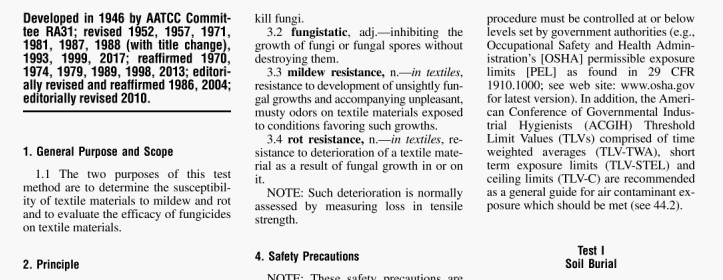Mildew and Rot Resistance of Textile Materials

AATCC 30-2017 pdf free.Antifungal Activity, Assessment on Textile Materials: Mildew and Rot Resistance of Textile Materials.401.2 Incubate cultures 7-10 days at 25 ± I C (77 ± 2°F). then store at 2- I0C 36-50F).
Preparation of conidial suspensions:
Conidial suspensions of fungal organisms are prepared by adding 10 ml. of a sterile 0.5% saline solution containing 0.05% of a non-ionic wetting agent (see 44.6) to a 7.10 day culture.
Scrape the surface of the culture gently with a sterile instrument (38.13) to liberate the spores. Agitate the liquid slightly to disperse the spores without detaching mycelial fragments, and gently decant the mold suspension into a flask containing a few glass beads.
Shake the dispersion vigorously to break up any clumps of spores and then filter through a thin layer of sterile cotton or glass wool. Conidial suspensions may he stored at 6 ± 4°C (43 ± 7F, for up 104 weeks.
Inoculum for lest should be adjusted using a hcmocyiomctcr or a Petrot’f-Hausser bacteria counter to contain 5 x HY± 2 x lO’conidiaimL on (by of usc by appropriate dilution of stock suspension with saline solution.
Preparation of test specimens:
To ensure luxuriant growth. both the test and control strips must be saturated with a sterilized glycerol nutrient solution of the following composition: 97.6% distilled water. 2A’ø glycerol. 0.1% K[IPO,. 0.1% NHNO, 0.05% MgSO.’ 7H(). 0.1% yeast extract and 0.05% of a non-ionic wctting agent (see 44.6). Adjust the pH to 6.3 * 0.1. Sufficient nutrient solution should be prepared to saturate all the specimens used in a single test.
Soak each strip in nutrient for three minutes or until saturated. Squeeze excess liquid and allow fabric strips to air diy before proceeding with application of test fungi.
Pre-mis equal volumes of well agitated conidial suspensions of A. niger. T i’iride and P. variwi. lsenly distribute 1.0 ± 0.1 mL of the above suspension onto both sides of each specimen either by spraying or by means of a pipette.
Suspend fabric strips using plastic paper clips or nylon thread from the caps of individual jars containing 90 ± 3 mL of water each. Hook position must be adjusled so that the bottom ends of attached strips arc all at a uniform height above the water level. The caps are tightened. then backed oFf one-eighth turn to allow for some ventilation.
405 Incubate at 2 ± I(’ 82 ± 2cF) [or 14 days for non-coated cellulosic textiles) or 28 days (for non-celluloxic or coated cellulosic textiles).
CalculatIons, Interpretation, and Evaluation
A record of the percent of suthice area covered with fungal growth for each strip is made at weekly intervals, or until heavy growth occurs on each sample replicate. Using a microscope (7-50x) where necessary, assess each specimen in accordance with the following scheme;Observed Growth No growth
Microscopic growth (visible only under the microscope)
Macroscopic growth (visible to the eye)
After 7 days each control strip must show macroscopic growth. If this is not the case, repeat the test since lest conditions were not valid.
Any adverse effect of incubation on the fabric; e.g., color changes, flexibility, water repellency, should be qualitatively reported.
Strength loss determination can be carried out as per 11.1.
The results of this lest method have to be correlated to claims and dirc*tions for use recommended for the mildew control product plus any other criteria agreed upon by the interested parties.
The report shall include the following:The test method and lest part.Size of test specimen used.Number of test specimen replicates used,Concentration of the tungal spore suspension.Pressure of the atomizer.
Publication available from U.S. Dcpartmcnt of Health & Human Sers ices— CDC/NIH-IIHS Publication No. (CDC) 84- 8395: web site: www.hhs.gov.
Booklet available from PuhbcatHms Office. ACOIFI, Kemper Woods Center. 1330 Kcmpcr Meadow Dr.. Cincinnati OIl 45240:
tel: +1.513.742.2020: web site: www.acgih.org.
Available from ASTM International.100 Barr Harbor, W. Consbnhockcn PA: Id:+1.6l0.X32,9500 web site: www.astni.org.
Types of soil which have been found satisfactoiy for this puipose include garden and naturall, trti1e topsoils. composts and non-sterile greenhouse potting soils. An equal blend of good topsoil, well roaed and shredded manure, and coarse sand should be used. These usually possess the proper physical characteristics, along with an organic content sLiftictent to ensure a high degree of microbial activity and the presence of cellulose destroying organisnis. l’he optimum moisture content of these is about 30% nsoislure abose oven dry weight.
Available from the American Type Culture Collection. P.O. Box 1549, Manassas VA 20108: tel: +1.703.365.2700; fax:+1.703.365.2701: web site: www.atcc.org.
Triton X-lOO, dioctyl sodium vullusuccinate and N-mcthyl-tauridc derivatives have been found to be good wetting agents. Do not use Polysorbate MO or Twecn WI as it Lv known to inactivate some antimicrobials.
Prepared culture medium having composition prescribed in 20.1 Mineral Salts Agar can be purehased from HiMedia Laboratories. A-516, Sssas(i& [)isha Busincss Park. via idhani Industrial Estate. LBS. Marg, Mumbai – 44X) 086. India. www.himedialabs.com M232 AATCC Mineral Salts Agar
If testing is being performed for Fed. eral Standards, use AATCC TM3O (Test Iii. Other organisms can be used: Mvrnthecium ss’rrtuaria ATCC 9095, QM 460: Tridtodermis virens ATCC 9645, QM 365: .Pvkmnoni da CChUWIU ATCC 11973. QM 1225:
Apeilus niger ATCC 6275. QM 458: Aspe, illio ciwuiw ATCC 18214. QM 862.AATCC 30 pdf download.Mildew and Rot Resistance of Textile Materials